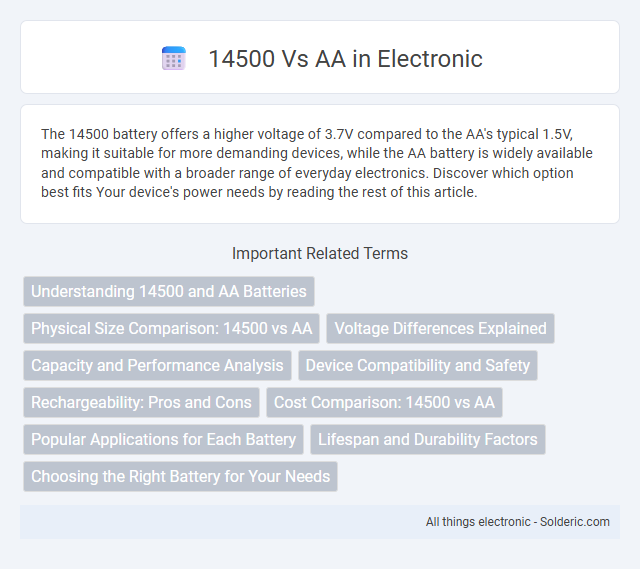The 14500 battery offers a higher voltage of 3.7V compared to the AA's typical 1.5V, making it suitable for more demanding devices, while the AA battery is widely available and compatible with a broader range of everyday electronics. Discover which option best fits Your device's power needs by reading the rest of this article.
Comparison Table
| Specification | 14500 Battery | AA Battery |
|---|---|---|
| Size | 14mm diameter x 50mm length | 14.5mm diameter x 50.5mm length |
| Voltage | 3.6V - 3.7V (Lithium-ion) | 1.2V - 1.5V (NiMH/Alkaline) |
| Capacity | 600mAh - 1200mAh | 1700mAh - 2800mAh |
| Chemistry | Lithium-ion | Alkaline or NiMH |
| Rechargeable | Yes | Yes (NiMH) / No (Alkaline) |
| Weight | ~23g | ~23g |
| Common Use | High-drain devices, flashlights, cameras | Remote controls, toys, clocks |
Understanding 14500 and AA Batteries
14500 batteries are lithium-ion rechargeable cells with a nominal voltage of 3.7V, whereas AA batteries are typically 1.5V alkaline or 1.2V NiMH rechargeable cells. The higher voltage and energy density of 14500 batteries make them suitable for high-drain devices, but their size and charging requirements differ significantly from AA batteries. Understanding your device's voltage compatibility is crucial before substituting AA with a 14500 battery to ensure safety and optimal performance.
Physical Size Comparison: 14500 vs AA
The 14500 battery measures approximately 14mm in diameter and 50mm in length, closely resembling the dimensions of a standard AA battery, which is about 14.5mm in diameter and 50.5mm in length. Despite their similar size, the 14500 is slightly narrower and shorter, enabling it to fit into devices designed for AA batteries but with a lithium-ion chemistry. This minor size difference allows the 14500 to be a direct physical replacement in many applications while offering higher voltage and capacity.
Voltage Differences Explained
The 14500 battery operates at a nominal voltage of 3.7 volts, significantly higher than the 1.5 volts provided by a standard AA battery. This voltage difference is crucial as it directly affects device compatibility and performance, with 14500 batteries powering high-drain electronics while AA batteries suit low-drain devices. Understanding these voltage specifications ensures safe usage and prevents damage to electronics designed for specific power requirements.
Capacity and Performance Analysis
The AA battery typically offers a capacity ranging from 1800 to 3000 mAh depending on the chemistry, while the 14500 battery, a lithium-ion rechargeable cell, provides around 600 to 800 mAh capacity but delivers higher voltage at 3.7V compared to the AA's 1.5V. In terms of performance, 14500 batteries excel in high-drain devices due to their consistent voltage output and rechargeable nature, whereas AA batteries are widely valued for their availability and compatibility in diverse electronics. Your device's power requirements determine whether the higher capacity of AA or the voltage and rechargeability of 14500 batteries are more suitable.
Device Compatibility and Safety
The 14500 battery, similar in size to an AA but with a higher voltage of 3.7V compared to 1.5V, is compatible only with devices designed for lithium-ion cells, making it unsuitable for standard AA battery-powered devices. Using a 14500 in a device rated for AA alkaline batteries can cause overheating, damage, or safety hazards due to the voltage difference. Ensure your device explicitly supports 14500 batteries to maintain safety and optimal performance.
Rechargeability: Pros and Cons
The Sanyo 14500 Li-ion battery offers superior rechargeability with up to 300-500 charge cycles, making it ideal for devices requiring frequent power replenishment, while AA alkaline batteries are typically single-use and non-rechargeable. Rechargeable AA NiMH batteries provide 500-1000 cycles but have lower energy density and voltage compared to 14500 cells, which deliver a consistent 3.7V versus AA's 1.5V. The 14500's higher rechargeability and voltage suit high-drain electronics, but require compatible chargers and circuit protection to prevent overcharging or thermal issues.
Cost Comparison: 14500 vs AA
14500 lithium-ion batteries typically cost more than AA alkaline batteries due to their higher energy density and rechargeable capabilities. While AA batteries are more affordable for single-use applications, 14500 batteries offer better long-term value by reducing replacement frequency. Your choice depends on balancing upfront cost with the benefits of rechargeability and performance.
Popular Applications for Each Battery
The 14500 battery is widely used in high-drain devices such as flashlights, vape pens, and portable electronics requiring rechargeable power sources with high energy density. In contrast, AA batteries dominate household and everyday applications like remote controls, wall clocks, toys, and wireless mice due to their widespread availability and versatility. Both battery types serve distinct purposes, with 14500 catering to specialized rechargeable needs and AA batteries preferred for general, disposable use.
Lifespan and Durability Factors
The 14500 battery typically offers a shorter lifespan due to its higher energy density compared to AA batteries, which are built for longer usage cycles and consistent power output. Durability factors for 14500 lithium-ion cells include sensitivity to overcharging and temperature extremes, whereas AA batteries, especially alkaline or NiMH types, generally exhibit greater resilience under varied conditions. Your choice depends on whether you prioritize long-lasting performance or compact, high-power delivery in devices.
Choosing the Right Battery for Your Needs
Choosing the right battery depends on your device's power requirements and size constraints; AA batteries typically offer 1.5 volts and are widely available for everyday electronics, while 14500 batteries deliver a higher capacity with 3.7 volts, making them suitable for high-drain devices like flashlights and cameras. Your decision should consider runtime, rechargeability, and device compatibility to ensure optimal performance. Understanding these key differences ensures you select a battery that meets your energy demands efficiently.
14500 vs AA Infographic

 solderic.com
solderic.com